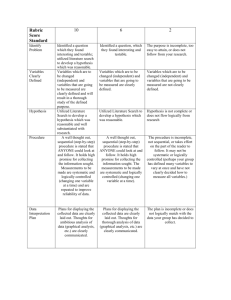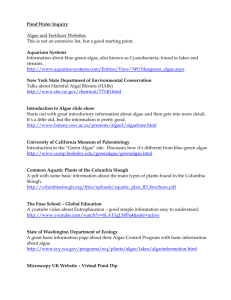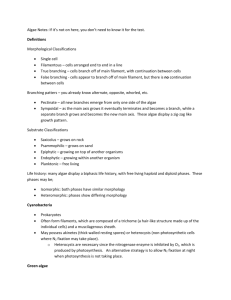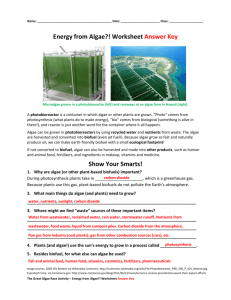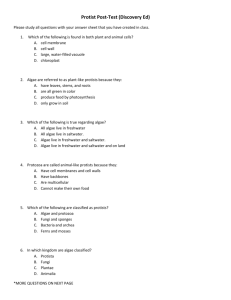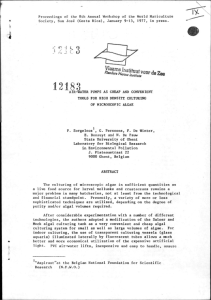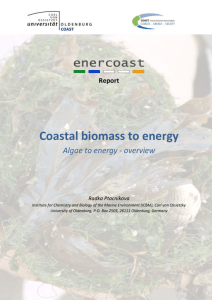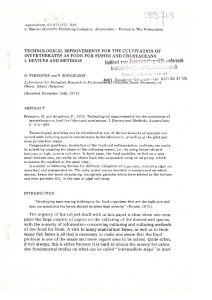Algae Proposal Rubric
advertisement
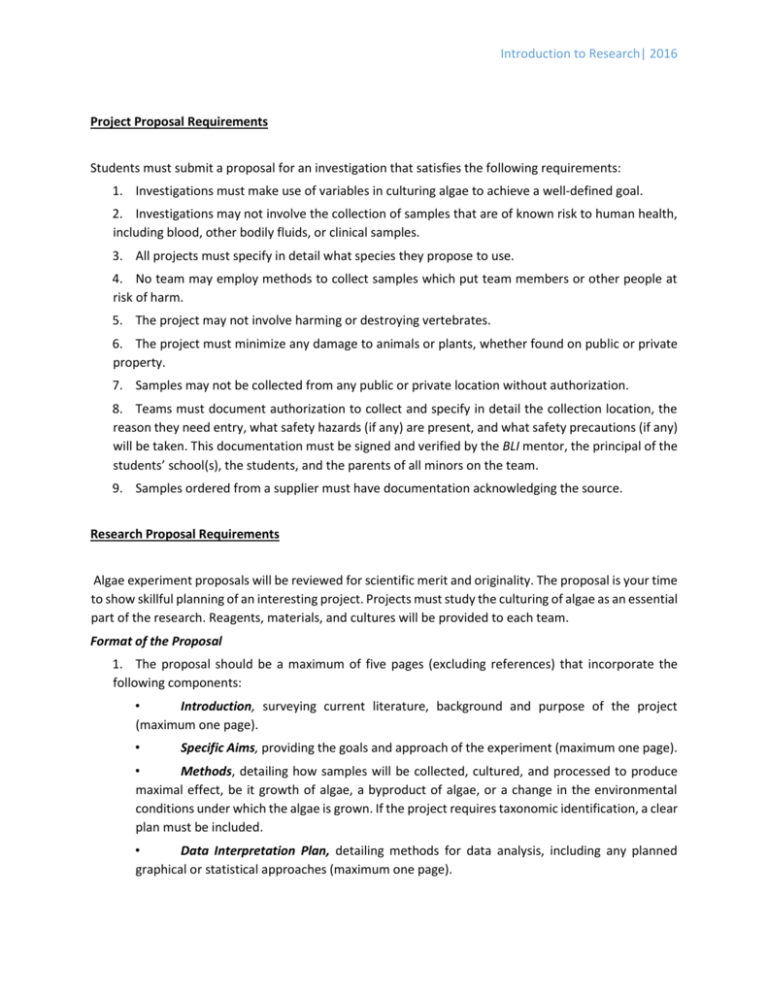
Introduction to Research| 2016 Project Proposal Requirements Students must submit a proposal for an investigation that satisfies the following requirements: 1. Investigations must make use of variables in culturing algae to achieve a well-defined goal. 2. Investigations may not involve the collection of samples that are of known risk to human health, including blood, other bodily fluids, or clinical samples. 3. All projects must specify in detail what species they propose to use. 4. No team may employ methods to collect samples which put team members or other people at risk of harm. 5. The project may not involve harming or destroying vertebrates. 6. The project must minimize any damage to animals or plants, whether found on public or private property. 7. Samples may not be collected from any public or private location without authorization. 8. Teams must document authorization to collect and specify in detail the collection location, the reason they need entry, what safety hazards (if any) are present, and what safety precautions (if any) will be taken. This documentation must be signed and verified by the BLI mentor, the principal of the students’ school(s), the students, and the parents of all minors on the team. 9. Samples ordered from a supplier must have documentation acknowledging the source. Research Proposal Requirements Algae experiment proposals will be reviewed for scientific merit and originality. The proposal is your time to show skillful planning of an interesting project. Projects must study the culturing of algae as an essential part of the research. Reagents, materials, and cultures will be provided to each team. Format of the Proposal 1. The proposal should be a maximum of five pages (excluding references) that incorporate the following components: • Introduction, surveying current literature, background and purpose of the project (maximum one page). • Specific Aims, providing the goals and approach of the experiment (maximum one page). • Methods, detailing how samples will be collected, cultured, and processed to produce maximal effect, be it growth of algae, a byproduct of algae, or a change in the environmental conditions under which the algae is grown. If the project requires taxonomic identification, a clear plan must be included. • Data Interpretation Plan, detailing methods for data analysis, including any planned graphical or statistical approaches (maximum one page). Introduction to Research| 2016 • References, outlines all sources used with internal citations. The reference section is not included in the five pages. Participants are encouraged to seek all forms of resources, journals, text books, and mentors in the field (no page limit set). 2. Proposal Margin and Spacing Requirements • Use one of the following typefaces: Arial 11 point or Times New Roman, 11 point • Margins, in all directions, must be 1 inch • Single spaced 3. Work submitted by student teams is expected to be of their own original design and execution, and presented in their own words. Full disclosure of any other person or resource that may have influenced the applicants’ proposal is required. The research project should reflect the work of the students. Students may receive review of their work and writing, but all alterations are to be that of the students. Team Information The name period, and role of each member of the team must be detailed Proposal Rubric The proposals will be reviewed using the following rubric. Each section will be scored out of a maximum number of points, indicated in the points earned column. Reviewers will use the guidelines in the following table when determining how many points to award for each section. Proposals will be ranked based on average points from all reviewers. Proposals that are incomplete or do not conform to the proposal guidelines may be returned to the students for further revisions. Introduction to Research| 2016 Proposal Rubric Attributes Introduction Hypothesis Methods Data Interpretation Plan Reference Section Above Standard At Standard Below Standard (10-9) (8.5-7) (7-0) Identified an interesting and testable question that relies on the culturing of algae towards an achievable goal. Identified an interesting, relevant, and testable question that can be answered culturing of algae towards an achievable goal. The purpose is incomplete, too easy to attain, does not involve culturing of algae or does not have an achievable goal. (5-4.5) (4-3.5) (3-0) Utilized literature search to develop a hypothesis which was reasonable and well substantiated. Utilized literature search to develop a hypothesis which was reasonable. Hypothesis is not complete or does not flow logically from research. (10-9) (8.5-7) (7-0) A well thought out, sequential (stepby-step) procedure is stated that ANYONE could look at and follow. It holds high promise for collecting the information sought. Measurements to be made are systematic and logically controlled (changing one variable at a time) and are repeated to improve reliability of data. A complete, sequential (stepbystep) procedure is stated but is difficult to follow. It holds promise for collecting the information sought. The measurements to be made are systematic and logically controlled (changing one variable at a time). The procedure is incomplete, not sequential, or takes effort on the part of the reader to follow. It may not be systematic or logically controlled (perhaps your group has defined many variables to vary at once and have not clearly decided how to measure all variables.) (5-4.5) (4-3.5) (3-0) Plans for displaying the collected data are clearly laid out (a table is STRONGLY recommended). Thoughts for ambitious analysis of data (graphical analysis, etc.) are clearly communicated. Plans for displaying the collected data are clearly laid out (a table is STRONGLY recommended). Thoughts for thorough analysis of data (graphical analysis, etc.) are clearly communicated. The plan is incomplete or does not logically match with the data your group has decided to collect. (5-4.5) (4-3.5) (3-0) A complete and properly formatted reference list is included. References to the literature are always marked in the body of the proposal. A partial or slightly and improperly formatted reference list is included. References to the literature are usually marked in the body of the proposal. The reference list is incomplete, difficult to use due to errors, or not marked correctly in the body of the proposal. Points Earned /10 /5 /10 /5 /5



